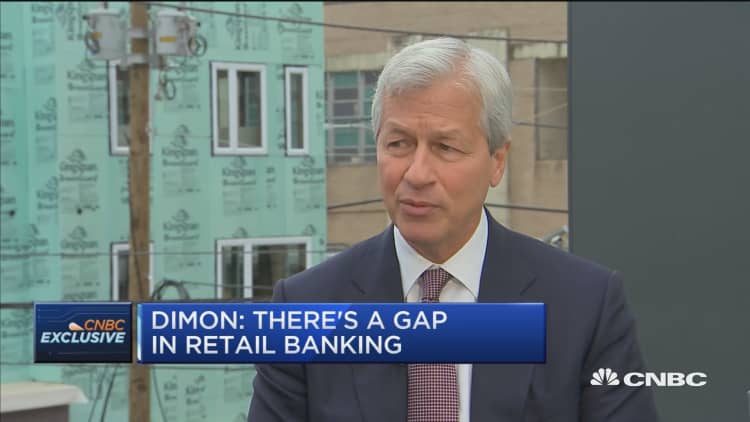By any measure, including their own third quarter financial reports, big U.S. banks are signaling the economy is on solid ground. And shares of these big banks jumped on Tuesday, suggesting investors are starting to believe them.
The nation's four biggest lenders and its two major investment banks posted mostly better than expected results, citing an increase in revenue from advising companies on deals, lending to consumers and businesses, and managing investor money. Bank executives point to a good environment, in which consumers are spending and companies are investing.
Goldman Sachs CFO Martin Chavez said Tuesday, "We remain cautiously optimistic, given active client dialogues, healthy economic growth and resilient investor sentiment."

Bank stocks reacted positively on Tuesday, led by Morgan Stanley, up nearly 6 percent, with Goldman up 3 percent and Bank of America and J. P. Morgan up over 2 percent.
Yet, this has not been the case for most of the year as the market has singularly focused on rising interest rates.
The fear played out last week, when major stock indexes erased 4 percent before a solid rebound Friday and Tuesday. Many bank stock investors seem to be asking whether and when rising rates will choke off economic activity, and bank profits along with it.
"Bank stocks are acting as though there's a recession around the corner," said Michael Mayo, a bank stock analyst at Wells Fargo & Co. of the longer term trend. "Bank fundamentals say anything but."
Goldman shares are down 14 percent year to date and Morgan Stanley's are down 13 percent, though both got a boost Tuesday after beating expectations for the third quarter. J, P. Morgan Chase shares are up just 1 percent this year, while fellow lending giant Bank of America is down 4 percent and Citigroup is down more than 6 percent. Wells Fargo shares are down 11 percent.
Gorman: 'Bewildering'
The KBW Bank index is also down about 6 percent since the beginning of January.
"It's kind of a little bewildering against the backdrop of a very strong U.S. economy," said Morgan Stanley CEO James Gorman on Tuesday, in response to an analyst question about the firm's stock price this year. "We're overweight the U.S. and gaining share across each of the institutional businesses."
Rising rates are both good and bad for banks: They boost profits from lending. But, when they get high enough, they tend to discourage companies and consumers from borrowing. There are other factors at play in the markets, however, including worries about trade skirmishes and political uncertainty.
J.P. Morgan Chase CEO Jamie Dimon raised concerns Friday that rising interest rates and geopolitical flareups could derail U.S. economic growth, but added that is not the case at the moment.
"The economy is still very strong, and that's across wages, job creation, capital expenditure, consumer credit; it's pretty broad-based and it's not going to be diminished immediately," Dimon said in a media conference call following his bank's earnings report. "I was pointing out the probabilities that I thought were higher that rates would go up. I still believe that. I do think you're going to see higher rates."
J. P. Morgan's outlook for loan growth, at 6 percent to 7 percent, is about where it was in April. Analysts have expressed fear that lenders would start to show slowing loan growth.
But bankers tried to temper those fears. Bank of America generated loan growth in the mid-single digits when the economy was expanding by 2 percent, and even if current economic growth above 3 percent slowed back down to that level, it could sustain that momentum, CEO Brian Moynihan said on a conference call with analysts on Monday. "We're comfortable in the 2 percent growth economy we can continue to do that."
New businesses
The big banks have been positioning to find new pockets of growth. Goldman is drumming up business with new companies and combing through its operations to find another $5 billion in revenues. J. P. Morgan and Bank of America are expanding their branch networks to new geographies. Wells Fargo is cutting costs.
PNC Financial Services, a regional lender in Pittsburgh, felt the brunt of investor fears about bank stocks. Its shares are down 10.7 percent in the last week and 14 percent this year.
The lender reported no meaningful change in loans and said growth was affected by an unexpectedly large amount of loan payoffs in the quarter and a lower amount of credit usage. But executives said they expect steady economic growth and one more rate hike this year. Loans are expected to increase modestly.
William Demchak, PNC's CEO, said, "What was weird about Q3 was we actually originated a lot of business. So, I'm actually pleased with the activity of our bankers and the number of new clients that we brought on board. I'm disappointed by the environment in the sense that utilization went down and we had pay-downs, but there's nothing I can do about that."
-- Hugh Son contributed reporting

